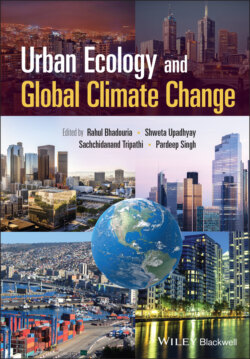Читать книгу Urban Ecology and Global Climate Change - Группа авторов - Страница 34
1.5.4 Urban Vegetation and CO2 Absorption
ОглавлениеVegetation stores a considerable amount of C in its different tissue components. Plants utilise the atmospheric CO2 in the photosynthetic pathway to produce food and store C in their tissues (e.g. stem, branch, and roots) (Velasco and Roth 2010), thus, continuously help in mitigation of CO2 emissions (Weissert et al. 2014). The C‐sequestration potential of the urban vegetation holds a key motivation for their plantation as the climate change adaptation strategies (Schadler and Danks 2011). Studies suggested that during plantation drives, those areas which have limited vegetation should be planted first followed by areas having sufficient green cover for the effective and long‐term understanding of the plant diversity, cover and health in relation to the surrounding conditions (Norton et al. 2015). Vegetation leads to reduction of atmospheric CO2 considerably as compared to the other sectors of the urban areas, particularly during the growing seasons (Vesala et al. 2008). In a comprehensive review, Weissert et al. (2014) observed that dense vegetation may act as a potential local sink of atmospheric CO2 in a city. They further reported that urban vegetation acts as a potential sink of atmospheric CO2 during the growing season in the mid‐latitude cities, whereas trees in tropical cities have the potential to absorb and sequester CO2 from the residential areas throughout the year. However, comprehensive measurements and understanding of urban vegetation C‐sequestration potential are still limited (Weissert et al. 2014). For example, the C‐sink (or CO2 uptake) potential of the urban vegetation may differ or considerably reduced when the overall emission of CO2 from the urban areas are included in the overall C‐budgeting (Weissert et al. 2014; Velasco et al. 2016; Zhao et al. 2016). Further, the C‐sequestration potential of urban vegetation depends on climatic conditions, plant species, and management practices (Weissert et al. 2014). Temperature and precipitation are two major factors determining the plant establishment and growth attributes, thus, influencing the biomass accumulation and C‐sequestration potential (Reich et al. 2014). Thus, changing climate scenario is also considerably impacting the C‐sequestration potential of vegetation (Richards et al. 2019). Therefore, detailed spatio‐temporal variation in urban vegetation C‐storage behaviour in different regions of the world is needed to develop effective climate change mitigation strategies.
